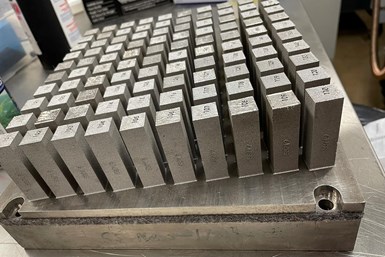Senvol Commercializes Siemens Energy’s Material Databases
Databases for Ti64, Inconel 625 and Inconel 718 were generated by Siemens Energy on its laser powder bed fusion machines. Although the data was initially intended exclusively for internal use, the company recently decided to make the data commercially available.
Share
Read Next
Senvol is commercializing various additive manufacturing (AM) databases of global energy technology company Siemens Energy. Commercialization will start with databases on Ti64, Inconel 625 and Inconel 718.
All three databases were generated by Siemens Energy on its laser powder bed fusion (LPBF) machines. Although the data was initially intended exclusively for internal use, the organization recently decided to make the data commercially available.
“This marks an extremely significant point in the additive manufacturing industry,” says Annie Wang, Senvol president. “Databases of this pedigree and magnitude are typically considered proprietary information and are not made commercially available to other organizations.”
The databases will be made available via Senvol’s wider Senvol Indexes product line. Senvol Indexes are data sets for AM material characterization. Each Senvol Index data set is sold individually and provides instantaneous access to AM data sets that would otherwise take months to develop. As with all Senvol Indexes, the Siemens Energy databases are being offered at a price that is just a fraction of the cost of development.
The databases are extensive, consisting of hundreds of specimens spread across dozens of tests, such as tensile, low cycle fatigue, high cycle fatigue and creep. Also, most of the tests were conducted at various temperature conditions.
- Read how AMT’s Emerging Technology Services is integrating a Senvol database to help provide the manufacturing technology community with additive manufacturing market insights.
- Learn how Senvol is demonstrating the use of machine learning software to enable path for rapid development of material property allowables for additive manufacturing.
- Check out this article on how Siemens Energy is applying additive manufacturing for power generation and more.
Related Content
-
Additive Manufacturing Is Subtractive, Too: How CNC Machining Integrates With AM (Includes Video)
For Keselowski Advanced Manufacturing, succeeding with laser powder bed fusion as a production process means developing a machine shop that is responsive to, and moves at the pacing of, metal 3D printing.
-
8 Cool Parts From Formnext 2023: The Cool Parts Show #65
New additive manufacturing technologies on display at Formnext were in many cases producing notable end-use components. Here are some of the coolest parts we found at this year’s show.
-
Zeda AM Production Plant in Ohio Now Open — Thoughts on the New Facility
73,000-square-foot metal powder bed fusion plant includes extensive machining capability plus separate operational models for serving medical versus other businesses.











.png;maxWidth=300;quality=90)





